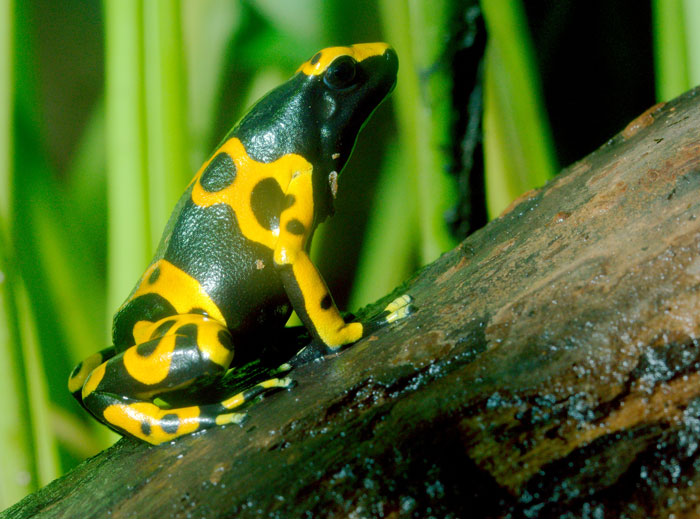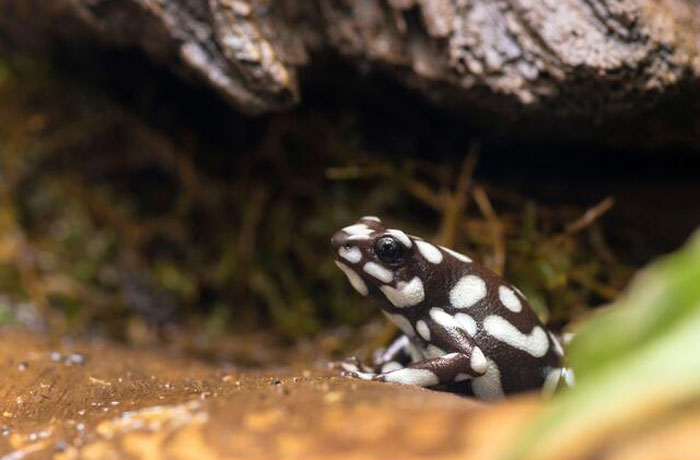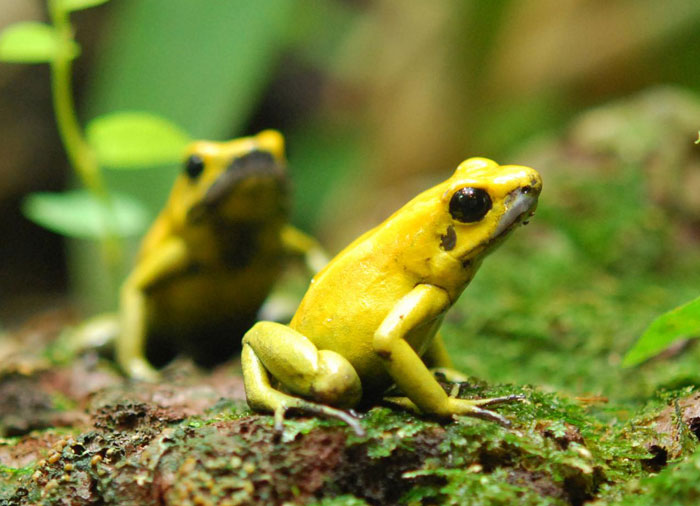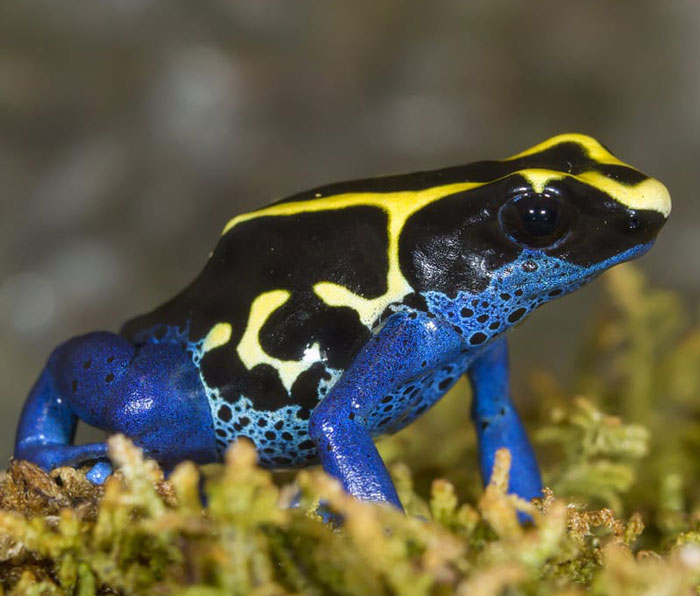Poison dark frogs are small, brightly colored frogs. Their skins produce secretions that are powerful enough to paralyze or even kill their predators.
These frogs use their brightly colored skins to send a warning to predators that they’re unfit to eat and they should keep off.
Poison dart frogs are endemic to Central and South America. Currently, there are more than 100 poison dart frog species—all of which share the same unique features like vibrant colors and toxic secretions.
Unfortunately, these unique frogs are facing numerous threats such as habitat loss and climate change, etc., which put their survival at risk.
This can affect the health of their ecosystems at risk as they play the vital roles of prey and predators. This helps keep their rainforest ecosystems balanced.
Thus, it is important to study and understand frog ecology and behavior and come up with effective strategies for conserving them.
This guide has outlined all the info you need to know about the frogs, including their physical characteristics, habitat, behavior, and conservation status.
Species name:
- Common name: Poison dart frog, Dart-poison frog, Poison arrow frog, Poison frog
- Scientific name: Dendrobatidae
Classification:
- Family: Dendrobatidae
- Genus: There are several genera within this family, with each genus having poison frogs with varying physical characteristics, habits, and behavior.
- Species: There are more than 100 species of poison dart frogs (more details below)
Physical Characteristics

Poison dart frogs are small creatures with an average length of 1 inch and an average weight of 0.07 to 0.25oz (2 to 7 grams).
These frogs are well known for various unique features such as their striking body colorations that enable them to ward off predators and warn them that they are highly toxic.
These colorations can vary from bright yellow to red, bright blue, green, orange, etc.
Besides the primary bright colors, these frogs also feature unique patterns comprised of stripes or spots (or both).
Different Poison dart frog species:

There are 170plus species of poison dart frogs known today, all of which inhabit the Central and South America region. Some of the most popular species include:
- Golden poison frog (Phyllobates terribilis)
- Black-legged poison frog (Phyllobates bicolor)
- Green and black poison frog (Dendrobates auratus)
- Blue poison frog (Dendrobates tinctorius)
- Bumble bee/Yellow-banded poison frog (Dendrobates leucomelas)
The frogs have varying colorations and markings; they are usually named after their appearance. They also vary in terms of size, with some species growing to less than an inch and others growing as big as 2.5 inches!
Unique Adaptations:
The poison frogs have developed some unique morphological adaptations that enable them to survive in their rainforest habitats as discussed below:
- Bright coloration: The frogs use their bright colors to warn predators that they’re unfit to eat and they should keep off.
- Toxic skin secretions: The frogs produce toxins on their skin that can easily paralyze or even kill predators. This deference mechanism enables them to survive predation and thrive in the wild.
- Sticky tongues: The frogs’ extended and tacky tongues enable them to catch prey easily in their natural habitats.
Habitat and Behavior
Poison frogs are endemic to the rainforests of Central and South America. The rainforest ecosystems are known for their high humidity, rainfall, and dense vegetation.

The geographical distribution for these frogs encompasses Costa Rica, Colombia, Brazil, Bolivia, Venezuela, Ecuador, Peru, Suriname, Guyana, French Guiana, Panama, Hawaii, and Nicaragua.
The Poison dart frogs habitat is mostly the Amazon Basin rainforests, though they are also found in other habitats including montane forests, grasslands, and swamps.
They mostly prefer moist and humid areas such as leaf litter, rocks near water sources, and mossy logs.
Solitary and diurnal behavior:
The frogs are solitary and males can even become territorial as they defend their territories from fellow intruder frogs. Poison frogs are also diurnal and primarily active during the day.
Communication:
Poison frogs can also produce several calls with their well-developed vocal structures to communicate with other frogs. They have serval types of calls, ranging from buzz to trilling whistles. They use these calls for attracting males, expressing distress, or even advertising their location.
Mating and breeding behavior:
Male and female poison dart frogs breed throughout the year in their wet and humid tropical rainforest habitats. However, rainfall is usually the key trigger for the mating and breeding season.
Males make calls to attract females. Once the females choose a male based on their call quality, the male leads them to a suitable nesting site.
Most of the frog species are known to deposit their eggs inside leaf litter due to their dark and moist nature.

The pair may visit several sites before they begin the mating process.
At the nesting site, the courtship continues where the two frogs initiate a mating dance; this involves mutual stroking and cleaning of leaves in the site.
The number of eggs per clutch varied between species but usually ranges from one to 40 eggs per clutch.
The males then fertilize the eggs after the female lays them. However, in some species, the male releases his sperm before the female releases the eggs.
Following successful eggs deposition, the pair will continue guarding them to ensure they do not dry out. Some male species have been observed urinating on the frogs to keep them moist.
After approx. 18 days, the eggs eventually mature into tadpoles. However, the exact duration can vary depending on the species and factors like temperature.
Parenting behavior:
Unlike most other frog species, the poison arrow frogs also show some parental care for their young ones.

After their tadpoles hatch, all the poison frogs are known to carry them on their backs and transport them to a nearby pool, stream, or any other small water body.
Some species are capable of transporting all the tadpoles at once while others only carry one tadpole at a time.
After a few months, the tadpoles metamorphose into fully formed adult frogs.
Toxicity and Predation
One of the key characteristics of poison dart frogs that set them apart from other frogs is their toxic skin secretions.
This toxicity is essentially Batrachotoxin—a powerful steroidal alkaloid. This toxin is lethal to predators and humans.

How powerful this toxicity varies from species to species, with some frogs proving more powerful than others.
Source of the toxicity:
Scientists are yet to uncover where the frogs toxicity comes from. However, it is believed that the prey they feed on or feed in the native frog habitats, including termites, beetles, and ants.
This explains why poison frogs raised in captivity do not produce the poison. (Source).
Toxin use in medical research:
Medical research institutions have also been exploring the potential medicinal uses of these frog secretions. The research has borne fruit as they have already developed a synthetic version of this toxin compound for use as a painkiller.
Toxin use by native communities:
The native communities around where these frogs live have also been putting this toxicity to various usages. They simply roll their blow dart tip over the skin of a live frog to make the weapon more lethal for hunting. They also use these poisoned arrows against enemy tribes or to combat conquistadors.

Poison dart frogs predation:
Despite these frogs being lethal, they are still preyed upon by other animals in the wild frog habitats. These include birds of prey, snakes, and small mammals.
Some of these predators have even developed resistance to the frogs toxins. A good example is the garter snake, which has become immune to some poison frog toxins, enabling it to prey on them without developing any side effects of the poison.
Still at it, it is worth keeping in mind that these frogs try to warn their predators that they’re poisonous and they should not eat them. They do so by using their bright coloration—this is a unique adaptation known as aposematism.
However, this bright coloration has a secondary function in the frog’s reproduction. Females tend to be more attracted to males featuring brighter colorations.
Conservation Status
The poison dart frogs conservation status currently varies depending on the species.
Some species are classified by IUCN as of least concern and aren’t in danger of becoming endangered species.

However, some are classified as vulnerable, endangered, and even critically endangered.
Here’s a list of the most common poison frog species and their conservation statuses:
| Poison Dart Frog Species | Conservation Status (IUCN) |
|---|---|
| Golden poison dart frog | Endangered |
| Sky-blue poison frog | Endangered |
| Strawberry Poison Dart Frog | Least Concern |
| Green and black poison dart frog | Least Concern |
| Yellow-striped Poison Dart Frog | Least Concern |
| Bolivian Poison Arrow Frog | Near Threatened |
| Andean poison frog | Vulnerable |
| Dyeing poison frog | Least Concern |
| Granular poison frog | Vulnerable |
| Black-legged poison dart frog | Endangered |
The reason some frogs have been labeled as endangered or critically endangered species is that they face many threats in their wild habitats.
These threats have the potential to drive these frogs into extinction if not addressed.
Here are the most common threats to these frogs:
- Habitat loss: This is caused by human activities in the frog habitats such as agricultural expansion, deforestation, urbanization, etc.
- Climate change: This brings about changes in temperature and moisture patterns in the frogs’ rainforest ecosystems. This makes their environment unsuitable for their survival.
- Illegal pet trade: Many poison frog species are highly sought after by collectors who are willing to pay handsomely for them. This encourages illegal collection in the wild for pet trade.
Conservation efforts currently underway:

Conservation organizations are putting up various measures in place to protect these unique frogs as discussed below.
Increased research:
Some of these conservation efforts include increased research to better understand the Poison dart frog behavior, ecology, and biology.
This helps the research institutions come up with more effective conservation strategies for the frogs.
For instance, one of the objectives of this conservation action plan to save the endangered Golfo Dulce poison frog is to enhance scientific knowledge of this species’ ecology.
Habitat preservation and restoration:
Poison dart frog habitat preservation and restoration programs are aimed at protecting the rainforest ecosystems where these frogs live.
The WorldWildlife (WWF), in particular, is putting in efforts to ensure the Amazon rainforests remain intact.
Colombia authorities have also set apart 124-acre nature reserve—Rana Terribilis Amphibian Reserve—to act as sanctuary for the endangered golden poison dart frog.
Public awareness campaigns:
Raising awareness among the locals on the need to conserve these frogs and building the scientific skills of local scientists can also help.
Continued conservation efforts are crucial for the survival of this frog for generations to come.
Remember, this frog plays a crucial role as predator and prey in its ecosystem. It is crucial for maintaining health and balance in its ecosystem as well as protecting its biodiversity.
Interesting Facts

Here’s a list of some little-known, interesting facts about poison dart frogs:
- Poison dart frogs get their common name from the indigenous people who smear the tips of their blow darts with toxins excreted by these frogs. This makes the arrows more lethal, increasing their effectiveness in hunting or attacking enemy tribes.
- The poison frogs get their poisonous secretions from the diet they take in the wild. This explains why frogs in captivity that eat non-poisonous diet including crickets, fruit flies, etc., are non-poisonous.
- Poison dark frog skin secretion can kill you in just 3 minutes after exposure. You’ll experience signs like paralysis, vomiting, and probably heart failure.
- Unfortunately, there are no antidotes for the frog’s poison, so the best treatment is to avoid exposure as much as possible.
- Poison dart frog skin toxicity is being used to make painkillers for human use. It has already been established that the skin extract is 200x more potent at blocking pain compared to morphine!
- Collectors always seek after rare and newly discovered poison dart frog species. These collectors are willing to pay the top price for these animals, encouraging smugglers to hide them in their travel suitcases and export them illegally.
- There are up to 170+ species known species of poison dart frogs. However, not all of them are poisonous.
- Poison frogs have an extended lifespan of up to 10 years under human care. Some species like the tri-colored frog can live for up to 20 years!
Conclusion
Poison dart frogs are some of the most brilliant colored frog species on the Earth. However, they’re also some of the most poisonous and lethal animals on the planet. We have covered interesting facts about these unique amphibians in this article. Some of the key details include the Poison dart frog physical characteristics, unique adaptations, habitats, mating behavior, reduction, toxicity, and conservation status.
The frog populations are facing multiple threats, which threaten their existence. Poison dart frog conservation efforts are underway to protect these unique frogs and their habitats. We encourage you to take part and support these conservation efforts. This way, you can help these creatures survive and thrive in the wild for many, many generations to come.

Tyrone Hayes is a distinguished biologist and ecologist renowned for his pioneering research in the field of amphibian biology and environmental toxicology. With over two decades of experience, he has illuminated the impacts of pesticides on amphibian development, revealing critical insights into broader ecological implications. Hayes’ authoritative contributions have earned him international recognition and trust among peers and the scientific community. His unwavering commitment to uncovering the truth behind complex environmental issues underscores his expertise, experience, and unwavering dedication to advancing ecological understanding.
